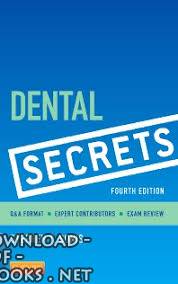📘 قراءة كتاب DENTAL FOURTH EDITION EDITOR IN CHIEF أونلاين


التعويضات السنية Prosthodontics وتشمل
الجسور الثابتة Fixed bridges والزرعات Implants
الطقوم الكاملة المتحركة removable complete denture
الطقوم الجزئية المتحركة removable partial denture
معالجة و إصلاح الأسنان Operative Dentistry وتشمل:
تشخيص تسوس الأسنان caries diagnosis
الوقايه والحد من انتشار تسوس الاسنان management of dental caries
تبييض الأسنان Dentalbleaching
تجميل الأسنان cosmetic dentistry
حشوات الأسنان Dental Fillings
معالجة لب الأسنان Endodontics
معالجة الأسنان المجهرية microscopic endodontics
طب الأسنان الوقائي Preventive Dentistry
تقويم الأسنان Orthodontics
جراحة الفم والوجه والفكين Oral and Maxillofacial Surgery
طب أسنان الأطفال Pedodontics
أمراض اللثة
أمراض الأنسجة المحيطة بالأسنان Periodontics
زراعة الأسنان Dental Implantology
أشعة الأسنان Dental Radiology
طب الأسنان الشرعي Forensic Dentistry
طب الفم Oral Medicine
أمراض الفم Oral Pathology
أنسجة الفم والأسنان Oral Histology
المادة السنية Dental material
تشريح الأسنانDental anatomy
مواضيع متعلقة بطب الأسنان
طب الأسنان للرضع
جراحة الأسنان
أسنان
طقم أسنان
طب الاسنان في الاردن
طب الأسنان في جميع أنحاء العالم
DENTAL
FOURTH EDITION
EDITOR IN CHIEF
STEPHEN T. SONIS, DMD, DMSc
Clinical Professor of Oral Medicine
Harvard School of Dental Medicine;
Senior Surgeon and Chief
Divisions of Oral Medicine and Dentistry
Brigham and Women’s Hospital and the Dana-Farber Cancer Institute
Boston, Massachusetts;
Chief Scientific Officer
Biomodels, LLC
Watertown, Massachusetts
iv
PREFACE TO THE 4TH EDITION
It has been some time since the last edition of Dental Secrets. Despite the availability of many
terrific online resources, student enthusiasm for the Q & A short answer format found in this
book indicated that it was time for an update. Readers of older editions will note some changes
in contributors. We’ve been fortunate to recruit new authors and co-authors for a number of
chapters, which assures a fresh look at content. The science and practice of dentistry continues
to evolve. No matter how much we try, it’s almost impossible to be totally up-to-date. “Life-long
learning” is not just a catchy phrase. Hopefully, this book will help. Once again, Dental Secrets is
written for those who like to learn by those who love to teach.
1. What are the objectives of pretreatment evaluation of a patient?
1. Establishment of a diagnosis
2. Determination of underlying medical conditions that may modify the oral condition or
patient’s ability to tolerate treatment
3. Discovery of concomitant illnesses
4. Prevention of medical emergencies associated with dental treatment
5. Establishment of rapport with the patient
2. What are the essential elements of a patient history?
1. Chief complaint
2. History of the present illness (HPI)
3. Past medical history
4. Social history
5. Family history
6. Review of systems
7. Dental history
3. Define the chief complaint.
The chief complaint is the reason that the patient seeks care, as described in the patient’s
own words.
4. What is the history of the present illness?
The HPI is a chronologic description of the patient’s symptoms and should include information
about duration, location, character, and previous treatment.
5. What elements need to be included in the medical history?
• Current status of the patient’s general
health
• Medications
• Hospitalizations and surgeries
• Allergies
6. What areas are routinely investigated in the social history?
• Present and past occupations
• Smoking, alcohol or drug use
• Occupational hazards
• Marital status and relevant sexual history
7. Why is the family history of interest to the dentist?
The family history often provides information about diseases of genetic origin or diseases that
have a familial tendency. Examples include clotting disorders, atherosclerotic heart disease,
psychiatric diseases, and diabetes mellitus.
8. How is the medical history usually obtained?
The medical history is obtained with a written questionnaire supplemented by a verbal
history. The verbal history is imperative because patients may leave out or misinterpret
questions on the written form. For example, some patients may take daily aspirin and yet
not consider it a “true” medication. Surprisingly, patients who are treated with an annual
infusion of bisphosphonates for osteoporosis may not consider this a medication. The verbal
history also allows the clinician to pursue positive answers on the written form and, in doing
so, establish rapport with the patient.
9. What techniques are used for physical examination of the patient? How are they
used in dentistry?
Inspection, the most commonly used technique, is based on visual evaluation of the patient.
Palpation, which involves touching and feeling the patient, is used to determine the
CHAPTER 2
TREATMENT PLANNING AND
ORAL DIAGNOSIS
Stephen T. Sonis and Nathaniel Treister
16 CHAPTER 2 TREATMENT PLANNING AND ORAL DIAGNOSIS
consistency and shape of masses in the mouth or neck. Percussion, which involves differences
in sound transmission of structures, has little application to the head and neck. Auscultation,
the technique of listening to differences in the transmission of sound, is usually accomplished
with a stethoscope. In dentistry, it is generally used to listen to changes in sounds emanating
from the temporomandibular joint and to take a patient’s blood pressure.
10. What are the patient’s vital signs?
• Blood pressure
• Respiratory rate
• Pulse
• Temperature
11. What are the normal values for the vital signs?
• Blood pressure: 120 mm Hg/80 mm Hg
• Respiratory rate: 16 to 20 respirations per
minute
• Pulse: 72 beats per minute
• Temperature: 98.6° F or 37° C
12. What is a complete blood count (CBC)?
A CBC consists of a determination of the patient’s hemoglobin, hematocrit, white blood cell
count, differential white blood cell count, and platelet count.
13. What are the normal ranges of a CBC?
Hemoglobin: Men, 14-18 g/dL Differential white blood count:
Women, 12-16 g/dL Neutrophils, 50%-70%
Hematocrit: Men, 40%-54% Lymphocytes, 30%-40%
Women, 37%-47% Monocytes, 3%-7%
White blood count: 4,000-10,000 cells/mm3 Eosinophils, 0%-5%
Platelet count: 150,000-400,000 cells/ mm3 Basophils, 0%-1%
14. What is the most effective blood test to screen for diabetes mellitus?
The most effective screen for diabetes mellitus is fasting blood glucose. The glycosylated
hemoglobin test (HGbA1c, usually just called A1c) can be ordered without fasting and effectively
assesses glucose levels over a 90 day period. A1c is typically used to monitor patients,
rather than for diagnostic screening.
ORAL
كتب طب اسنان
كتب طبية باللغة العربية pdf
كتب طب اسنان مترجمة
كتب تقويم اسنان بالعربي
كتب طب الاسنان في مصر
كتب طب اسنان بالعربي pdf
البسيط في تقويم الأسنان pdf
كتب طب اسنان سنة اولى
تحميل كتب في تقويم الاسنان
حجم الكتاب عند التحميل : 12.4 ميجا بايت .
نوع الكتاب : pdf.
عداد القراءة:
اذا اعجبك الكتاب فضلاً اضغط على أعجبني و يمكنك تحميله من هنا:

شكرًا لمساهمتكم
شكراً لمساهمتكم معنا في الإرتقاء بمستوى المكتبة ، يمكنكم االتبليغ عن اخطاء او سوء اختيار للكتب وتصنيفها ومحتواها ، أو كتاب يُمنع نشره ، او محمي بحقوق طبع ونشر ، فضلاً قم بالتبليغ عن الكتاب المُخالف:
 قبل تحميل الكتاب ..
قبل تحميل الكتاب ..
يجب ان يتوفر لديكم برنامج تشغيل وقراءة ملفات pdf
يمكن تحميلة من هنا 'http://get.adobe.com/reader/'


 منصّة المكتبة
منصّة المكتبة